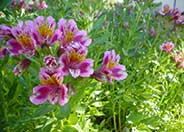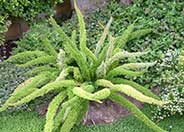
Common name:Muskogee Crape Myrtle
Botanical name:Lagerstroemia 'Muskogee'
This Crape Myrtle hybrid is a popular tree which grows to 25' tall and 12' wide. It blooms with lavender flowers in the summer; leaves turn red in fall. It is mildew resistant and does well in areas with hot summers. Crape Myrtles bloom on new wood so prune in winter or early spring to increase flowering. - Carolyn Shaffer, Dudek and Associates

Common name:Peruvian Lily, Alstroemeria
Botanical name:Alstroemeria hybrids
The deciduous rhizomes of this Peruvian Lily will often run aggressively if not controlled. They grow best in full to partial sun with some summer watering in dry climates. The florist strains can reach 6' tall, while the compact strains range from 12" 36" tall. For extra long, florist quality stems, stake or grow through netting for support. -Moterey Bay Nursery

Common name:Myers Asparagus
Botanical name:Asparagus densiflorus 'Myers'
An evergreen groundcover, the 'Myers' also makes an excellent hanging basket plant when larger in size. Its formal looking fronds have an even, spiral arrangement of leaflets. It is damaged by severe frosts, and looks best with at least occasional watering. -Monterey Bay Nursery

Common name:Catmint
Botanical name:Nepeta X faassenii
Nepeta faassenii makes soft, gray green, undulating mounds that are 1.5' high when blooming. The small leaves are attractive to cats. This perennial has lavender blue flowers in late spring and early summer.

Common name:Japanese Boxwood
Botanical name:Buxus microphylla japonica
Japanese Boxwood is often used as a hedge. It is compact, with small bright green leaves. It can reach 4'-6' tall and wide or be kept smaller through pruning. It can be sheared to shape. It does better in areas with milder winters.
Solving Runoff Problems
Importance of Watershed
A watershed is a land area that drains rain and other water into a creek, river, lake, wetland, or groundwater aquifer. Water from your neighborhood also enters the watershed through the storm drain system and flows directly to local creeks without any treatment. It often is contaminated by pollutants that can be toxic to fish, wildlife, and people.Click in the green box for more information
| Designer: Nan Simonsen Nanscapes | Looking Back Towards the House |
Photographer: GardenSoft |
Soils and Compost:
Maintain a two to four inch layer of mulch on the soil surface to reduce weeds, infiltrate rain water, and reduce compaction.
Water Saving Tip:
Integrated Pest Management:
Remove irrigation water and fertilizer from areas where you don't want weeds to grow.

